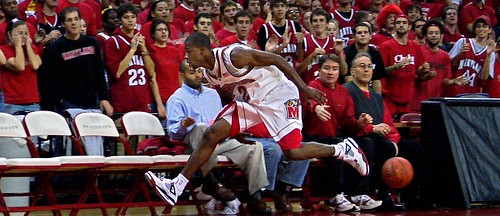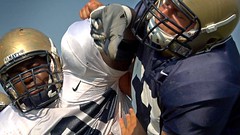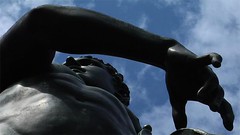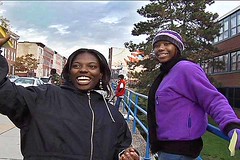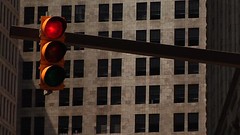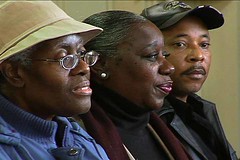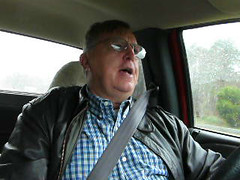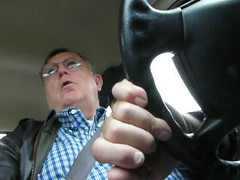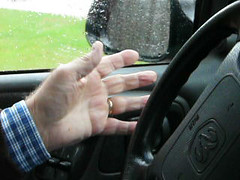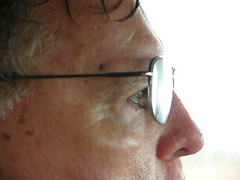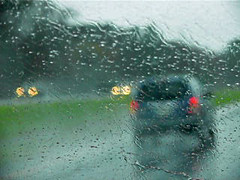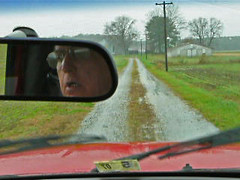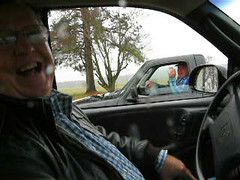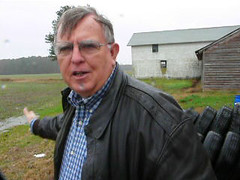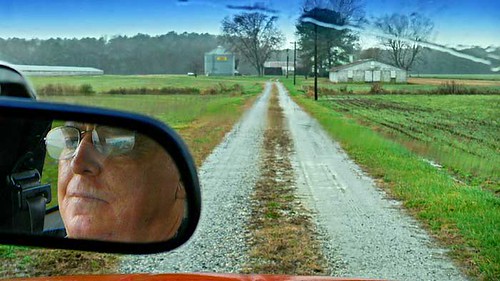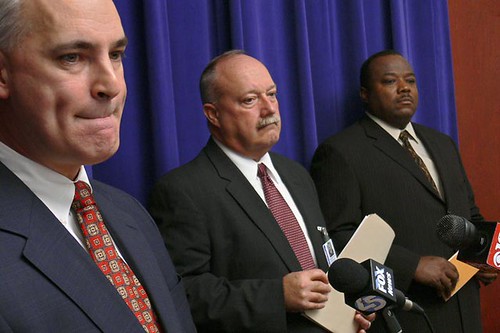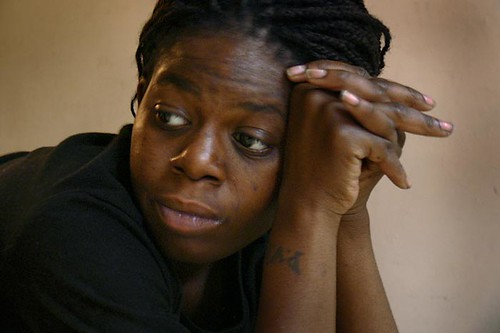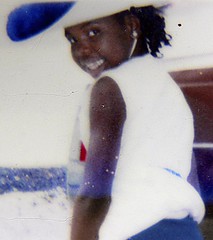Stage fright.
You may get over it, but you never forget it.
I just finished with the guest speakers at McDaniel College in Westminster, MD, and I still get nervous when all eyes stare back at me! Terry Dalton, who has hosted the annual event in which professionals - mainly from different news-gathering entities - visit his class to share information about their field of work.
I had told Terry back in the summer that I had a surprising presentation and couldn't wait for November, yet I actually had nothing in hand to show. Usually, the talk would revisit the year's work. Last year, I shared my images from Hurricane Katrina and the Indonesian tsunami. This year, I felt my work was seriously lacking, since I've been swamped with learning the HVX200.
Being stoked about the shift towards multimedia journalism, called "the voice in the story," I gathered some finished work from some of the staff. Algerina's sound slides of the Basilica, Monica's work on Factor VII, David Hobby's images of a tree in the fall, and Chiaki's piece about the Pleasant family's double-whammy cancer fight were some pieces short and good enough to send a message. I saved Barb's project on Recher Rock for last, just to let the class watch a little about indie bands.
The message was the same that I learned months ago: don't just be a photographer. Or a camera operator. Or a reporter, or audio technician, gathering for radio. Do all of those things, and learn through practice. Being sure to make eye contact, I didn't let the students know that I'm actually introverted. Well, I did hint at that, when sharing the fact that I feel more comfortable behind the camera, silently documenting others.
Maryland Terrapins' DJ Strawberry hustles and dives after ball!!
Ending the chat with some HVX footage of a basketball and a cool clip I shot at a Maryland Terrapins game (which is WAY down-rezzed by the YouTube folks, but I hope you still can enjoy it), a couple of those listening seemed a bit in disbelief that people are actually doing well by creating multimedia projects and blogging online. One, who stayed after class, picked my brain about the concept.
Everyone in her class has taken photos. With the cameras of today, anyone can take a pretty darn good image, if they work on it. Regarding the hybrid cameras, just a couple of clicks on the dial, and your still digital can instantly begin capturing sound and video. So, if you have any kind of light budget (or know someone who wants to loan you the gear) you can put a hybrid camera in your hot mitts and start teaching yourself about how to document the world around you.
The important thing I failed to share was that a web visitors can be limitless. Instead of showing your product to your friends, you now have an audience that's worldwide (depending on internet access and whether any particular country will allow your work to be accessed). Newspapers have always trained their sights on local coverage. But the web allows for worldwide viewing of whatever might be published. So if a newspaper's subscription total was 250,000, locally, it would be seen by an estimated 500,000 people.
On the web, there are billions of people online, and the viewers are growing in numbers, so there will always be an audience, until or unless the web decides to stop or change. No one can even fathom that happening, so the only one stopping you, is you. The web has opened the whole world to those who can access it. And it lets you and I be our own journalists, columnists, publicists, critics, managing editors and publishers. That's why big media has stumbled. People now have the ability to cover each other. Instead of waiting for the local news at 6pm, or the next day's paper,you and I can simply post it online ourselves. CNN and Fox have been getting their news clips and information from daily blogs and YouTube posts. The infamous video of "Kramer" Richards losing control? It was captured by an audience member's cell phone.
Find your niche and work on it. Whether it's a sport (or love of one), a hobby, a particular rant you care to vent, or the latest bad driver that carelessly drove past you, remember the most important thing: many people are just like you, and feel the same way. And they're currently Googling phrases that you could have already been writing about.
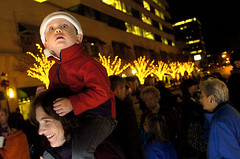
Conor gazes into the night, his eyes trying to spot Santa and Mrs. Claus.
As for this blog entry, much of it was written in the parking lot of a Cactus Willie's during some down time between jobs. The rest was finished here, at a Panera Bread in north Baltimore, after I transmitted pictures of 4-year-old Conor, searching the skies for Santa at a tree lighting ceremony. So, keep your laptop with you, at all times; at some moment, you may suddenly get the urge to fire up your PowerBook and pound your keyboard during a brainstorm.
Don't give up on your passion if no one flocks to your site at first. If you want that, you have to expose your site and make it searchable and easily-accessed. That's one reason why I've switched from MySpace, since they require membership, just to view a person's page.
You may get over it, but you never forget it.
I just finished with the guest speakers at McDaniel College in Westminster, MD, and I still get nervous when all eyes stare back at me! Terry Dalton, who has hosted the annual event in which professionals - mainly from different news-gathering entities - visit his class to share information about their field of work.
I had told Terry back in the summer that I had a surprising presentation and couldn't wait for November, yet I actually had nothing in hand to show. Usually, the talk would revisit the year's work. Last year, I shared my images from Hurricane Katrina and the Indonesian tsunami. This year, I felt my work was seriously lacking, since I've been swamped with learning the HVX200.
Being stoked about the shift towards multimedia journalism, called "the voice in the story," I gathered some finished work from some of the staff. Algerina's sound slides of the Basilica, Monica's work on Factor VII, David Hobby's images of a tree in the fall, and Chiaki's piece about the Pleasant family's double-whammy cancer fight were some pieces short and good enough to send a message. I saved Barb's project on Recher Rock for last, just to let the class watch a little about indie bands.
The message was the same that I learned months ago: don't just be a photographer. Or a camera operator. Or a reporter, or audio technician, gathering for radio. Do all of those things, and learn through practice. Being sure to make eye contact, I didn't let the students know that I'm actually introverted. Well, I did hint at that, when sharing the fact that I feel more comfortable behind the camera, silently documenting others.
Maryland Terrapins' DJ Strawberry hustles and dives after ball!!
Ending the chat with some HVX footage of a basketball and a cool clip I shot at a Maryland Terrapins game (which is WAY down-rezzed by the YouTube folks, but I hope you still can enjoy it), a couple of those listening seemed a bit in disbelief that people are actually doing well by creating multimedia projects and blogging online. One, who stayed after class, picked my brain about the concept.
Everyone in her class has taken photos. With the cameras of today, anyone can take a pretty darn good image, if they work on it. Regarding the hybrid cameras, just a couple of clicks on the dial, and your still digital can instantly begin capturing sound and video. So, if you have any kind of light budget (or know someone who wants to loan you the gear) you can put a hybrid camera in your hot mitts and start teaching yourself about how to document the world around you.
The important thing I failed to share was that a web visitors can be limitless. Instead of showing your product to your friends, you now have an audience that's worldwide (depending on internet access and whether any particular country will allow your work to be accessed). Newspapers have always trained their sights on local coverage. But the web allows for worldwide viewing of whatever might be published. So if a newspaper's subscription total was 250,000, locally, it would be seen by an estimated 500,000 people.
On the web, there are billions of people online, and the viewers are growing in numbers, so there will always be an audience, until or unless the web decides to stop or change. No one can even fathom that happening, so the only one stopping you, is you. The web has opened the whole world to those who can access it. And it lets you and I be our own journalists, columnists, publicists, critics, managing editors and publishers. That's why big media has stumbled. People now have the ability to cover each other. Instead of waiting for the local news at 6pm, or the next day's paper,you and I can simply post it online ourselves. CNN and Fox have been getting their news clips and information from daily blogs and YouTube posts. The infamous video of "Kramer" Richards losing control? It was captured by an audience member's cell phone.
Find your niche and work on it. Whether it's a sport (or love of one), a hobby, a particular rant you care to vent, or the latest bad driver that carelessly drove past you, remember the most important thing: many people are just like you, and feel the same way. And they're currently Googling phrases that you could have already been writing about.

Conor gazes into the night, his eyes trying to spot Santa and Mrs. Claus.
As for this blog entry, much of it was written in the parking lot of a Cactus Willie's during some down time between jobs. The rest was finished here, at a Panera Bread in north Baltimore, after I transmitted pictures of 4-year-old Conor, searching the skies for Santa at a tree lighting ceremony. So, keep your laptop with you, at all times; at some moment, you may suddenly get the urge to fire up your PowerBook and pound your keyboard during a brainstorm.
Don't give up on your passion if no one flocks to your site at first. If you want that, you have to expose your site and make it searchable and easily-accessed. That's one reason why I've switched from MySpace, since they require membership, just to view a person's page.
